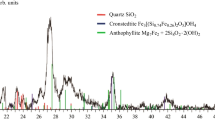Abstract
The results of studies of vermiculite rock from the Tebinbulak deposit are given. It is established that this vermiculite rock consists of biotite mica minerals. The crystalline lattice of these minerals contains interpack water known as zeolite water, which is responsible for swelling of the rock in heating. Vermiculite rock fired at 200–900°C is capable of absorbing water, i.e., of rehydration. This is important in using swelled vermiculite in the production of fire-retardant paints. The compositions of fire-retardant paints and the results of their testing for heat resistance according to GOST 30402 are given. It is established that all the developed mixtures impart fired-retardant properties to timber.
Similar content being viewed by others
References
A. Ts. Afanasiev, “Mineralogical characteristics of vermiculite from the Kovdor deposit and aspects of its genesis,” in: Proc. of Conf. on Vermiculite [in Rissian], Apatity, Kola Branch of AN SSSR (1963).
V. I. Ternovoi, “Genetic study of the Kovdor vermiculite-phlogopite deposit and search for new vermiculite and phlogopite deposits on the Kola Peninsula,” in: Proc. of Conf. on Vermiculite [in Rissian], Apatity, Kola Branch of AN SSSR (1963).
P. P. Tokmakov, The Kovdor Vermiculite Deposit and Conditions for Its Formation. Petrography and Mineralogy of Deposits of Perlite, Ceramic Feedstock, and Mica [in Rissian], Izd. AN SSSR, Moscow (1961).
P. P. Tokmakov and S. I. Berkhin, “Relations between the basal interplanar distances in magnesium-ferrous hydromica and their composition and physicomechanical properties”, Rentgenogr. Miner. Syr’ya, No. 3, 12–17 (1963).
S. I. Khvostenkov, A. F. Turkin, O. M. Timoshenko, et al., A Study of Some Physicochemical Properties of the Phlogopite-Vermiculite Series in the Kovdor Deposit [in Rissian], Nauka, Moscow (1966).
P. A. Arifov, T. T. Riskiev, V. I. Andronova, et al., “Tebinbulak vermiculite as a promising heat-insulating material,” Nov. Ogneupory, No. 5, 12–13 (2003).
Author information
Authors and Affiliations
Additional information
__________
Translated from Novye Ogneupory, No. 5, pp. 24–29, May, 2007.
Rights and permissions
About this article
Cite this article
Andronova, V.I. A study of the crystalline structure of vermiculite from the Tebinbulak deposit. Refract Ind Ceram 48, 91–95 (2007). https://doi.org/10.1007/s11148-007-0035-3
Received:
Issue Date:
DOI: https://doi.org/10.1007/s11148-007-0035-3




